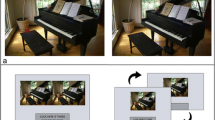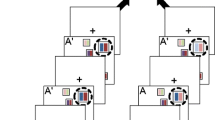Abstract
Responses to centrally presented target stimuli are faster when they are accompanied by a task-irrelevant lateral accessory stimulus that corresponds spatially with the response hand (accessory variant of the Simon effect). In four experiments, we tested whether this effect depends on the awareness of the accessory stimulus. In a change blindness task, participants were asked to respond to a central letter that was accompanied by a lateral background change on some trials. Change blindness describes the phenomenon that even large changes may remain unnoticed when they occur simultaneously with another visual disruption, e.g., a blank screen. In a series of four experiments, a significant Simon effect was observed both when the accessory stimulus reached awareness and when it remained unnoticed. These results indicate that, based on the spatial location of an accessory stimulus, a spatial code is generated. This code interferes with the response code on the response-selection stage.


Similar content being viewed by others
Notes
1 This criterion was not applied to Experiments 2–4 because it is possible to prepare a response to T2 before the display asking to report the change is presented. Unfortunately, the experimental code did not allow re-coding responses in Experiment 1.
References
Beck, D. M., Rees, G., Frith, C. D., & Lavie, N. (2001). Neural correlates of change detection and change blindness. Nature Neuroscience, 4, 645–650.
Block, N. (1996). How can we find the neural correlate of consciousness? Trends in Neurosciences, 19, 456–459.
Busch, N. A., Frund, I., & Herrmann, C. S. (2010). Electrophysiological evidence for different types of change detection and change blindness. Journal of Cognitive Neuroscience, 22, 1852–1869.
Cohen, J. (1988). Statistical power analysis for the behavioral sciences. Hillsdale: Erlbaum.
Coles, M. G. (1989). Modern mind-brain reading: psychophysiology, physiology, and cognition. Psychophysiology, 26, 251–269.
de Jong, R., Liang, C.-C., & Lauber, E. (1994). Conditional and unconditional automaticity: a dual-process model of effects of spatial stimulus–response correspondence. Journal of Experimental Psychology: Human Perception and Performance, 20, 731–750.
de Jong, R., Wierda, M., Mulder, B., & Mulder, L. J. (1988). Use of partial information in response processing. Journal of Experimental Psychology: Human Perception and Performance, 14, 682–692.
Dehaene, S., Naccache, L., Le Clec’H, G., Koechlin, E., Mueller, M., Dehaene-Lambertz, G., et al. (1998). Imaging unconscious semantic priming. Nature, 395, 597–600.
Eimer, M., & Mazza, V. (2005). Electrophysiological correlates of change detection. Psychophysiology, 42, 328–342.
Eimer, M., & Schlaghecken, F. (1998). Effects of masked stimuli on motor activation: behavioral and electrophysiological evidence. Journal of Experimental Psychology: Human Perception and Performance, 24, 1737–1747.
Fernandez-Duque, D., & Thornton, I. M. (2000). Change detection without awareness: do explicit reports underestimate the representation of change in the visual system? Visual Cognition, 7, 323–344.
Galfano, G., Mazza, V., Tame, L., Umiltà, C., & Turatto, M. (2008). Change detection evokes a Simon-like effect. Acta Psychologica, 127, 186–196.
Gratton, G., Coles, M. G., Sirevaag, E. J., Eriksen, C. W., & Donchin, E. (1988). Pre- and post-stimulus activation of response channels: a psychophysiological analysis. Journal of Experimental Psychology: Human Perception and Performance, 14, 331–344.
Green, D. M., & Swets, J. A. (1966). Signal detection theory and psychophysics. New York: Wiley.
Hedge, A., & Marsh, N. W. A. (1975). The effect of irrelevant spatial correspondence on two-choice response time. Acta Psychologica, 39, 427–439.
Hommel, B. (1994). Spontaneous decay of reponse-code activation. Psychological Research, 56, 261–268.
Koivisto, M., & Revonsuo, A. (2003). An ERP study of change detection, change blindness, and visual awareness. Psychophysiology, 40, 423–429.
Kornblum, S., Hasbroucq, T., & Osman, A. (1990). Dimensional overlap. Cognitive basis for stimulus–response compatibility: a model and taxonomy. Psychological Review, 97, 253–270.
Leuthold, H., & Kopp, B. (1998). Mechanism of priming by masked stimuli: inferences from event-related brain potentials. Psychological Science, 9, 263–269.
Lu, C. H., & Proctor, R. W. (1995). The influence of irrelevant location information on performance: a review of the Simon and the spatial Stroop effects. Psychonomic Bulletin & Review, 2, 174–207.
Mack, A., & Rock, I. (1998). Inattentional blindness. Cambridge, MA: MIT-Press.
Macmillan, N. A. (1993). Signal detection theory as data analysis method and psychological decision model. In G. Keren & C. Lewis (Eds.), A handbook for data analysis in the behavioral sciences: Methodological issues (pp. 21–57). Hillsdale, NJ: Erlbaum.
Macmillan, N. A., & Creelman, D. C. (1990). Response bias: characteristics of detection theory, threshold theory, and “nonparametric” indexes. Psychological Bulletin, 107, 401–413.
Miller, J., & Hackley, S. A. (1992). Electrophysiological evidence for temporal overlap among contingent mental processes. Journal of Experimental Psychology: General, 121, 195–209.
Milner, A. D. (1998). Streams and consciousness: visual awareness and the brain. Trends in Cognitive Sciences, 2, 25–30.
Mitroff, S. R., Simons, D. J., & Franconeri, S. L. (2002). The siren song of implicit change detection. Journal of Experimental Psychology: Human Perception and Performance, 28, 798–815.
Moore, C. M., Lleras, A., Grosjean, M., & Marrara, M. T. (2004). Using inattentional blindness as an operational definition of unattended: the case of a response-end effect. Visual Cognition, 11, 705–719.
Neumann, O., Ansorge, U., & Klotz, W. (1998). Functional differentiation in the visual cortex: basis for motor activation by not consciously perceived stimuli? Psychologische Rundschau, 49, 185–196.
Rensink, R. A. (2002). Change detection. Annual Review of Psychology, 53, 245–277.
Rensink, R. A. (2004). Visual sensing without seeing. Psychological Science, 15, 27–32.
Rensink, R. A., O’Regan, J. K., & Clark, J. J. (1997). To see or not to see: the need for attention to perceive changes in scenes. Psychological Science, 8, 368–373.
Rensink, R. A., O’Regan, J. K., & Clark, J. J. (2000). On the failure to detect changes in scenes across brief interruptions. Visual Cognition, 7, 127–145.
Schankin, A., Valle-Inclán, F., & Hackley, S. A. (2010). Compatibility between stimulated eye, target location and response location. Psychological Research, 74, 291–301.
Schankin, A., & Wascher, E. (2007). Electrophysiological correlates of stimulus processing in change blindness. Experimental Brain Research, 183, 95–105.
Simon, J. R., & Craft, J. L. (1970). Effects of an irrelevant auditory stimulus on visual choice reaction time. Journal of Experimental Psychology, 86, 272–274.
Simon, J. R., & Rudell, A. P. (1967). Auditory S-R compatibility: the effect of an irrelevant cue on information processing. Journal of Applied Psychology, 51, 300–3004.
Stanislaw, H., & Todorov, N. (1999). Calculation of signal detection theory measures. Behavior Research Methods, Instruments, and Computers, 31, 137–149.
Stoffer, T. H., & Umiltà, C. (1997). Spatial coding with reference to the focus of attention in S-R compatibility and the Simon effect. In B. Hommel & W. Prinz (Eds.), Theoretical issues in S-R compatibility (pp. 181–208). Amsterdam: North-Holland.
Stürmer, B., Leuthold, H., Soetens, E., Schröter, H., & Sommer, W. (2002). Control over location-based response activation in the Simon task: behavioral and electrophysiological evidence. Journal of Experimental Psychology: Human Perception and Performance, 28, 1345–1363.
Treccani, B., Umiltà, C., & Tagliabue, M. (2006). Simon effect with and without awareness of the accessory stimulus. Journal of Experimental Psychology: Human Perception and Performance, 32, 268–286.
Tse, P. U. (2004). Mapping visual attention with change blindness: new directions for a new method. Cognitive Science, 28, 241–258.
Umiltà, C., & Nicoletti, R. (1992). An integrated model of the Simon effect. In J. Alegría, D. Holender, J. Junca de Morais, & M. Radeau (Eds.), Analytic approaches to human cognition (pp. 331–350). Amsterdam: Elsevier.
Valle-Inclán, F., Hackley, S. A., & De Labra, C. (2003). Stimulus–response compatibility between stimulated eye and response location: implications for attentional accounts of the Simon effect. Psychological Research, 67, 240–243.
Valle-Inclán, F., Sohn, F., & Redondo, M. (2008). Spatial compatibility between stimulated eye and response location. Psychophysiology, 45, 279–285.
Vorberg, D., Mattler, U., Heinecke, A., Schmidt, T., & Schwarzbach, J. (2003). Different time courses for visual perception and action priming. Proceedings of the National Academy of Sciences of the United States of America, 100, 6275–6280.
Wascher, E., Schatz, U., Kuder, T., & Verleger, R. (2001). Validity and boundary conditions of automatic response activation in the Simon task. Journal of Experimental Psychology: Human Perception and Performance, 27, 731–751.
Author information
Authors and Affiliations
Corresponding author
Rights and permissions
About this article
Cite this article
Schankin, A., Hagemann, D. & Wascher, E. Simon effects in change detection and change blindness. Psychological Research 79, 1022–1033 (2015). https://doi.org/10.1007/s00426-014-0628-7
Received:
Accepted:
Published:
Issue Date:
DOI: https://doi.org/10.1007/s00426-014-0628-7




